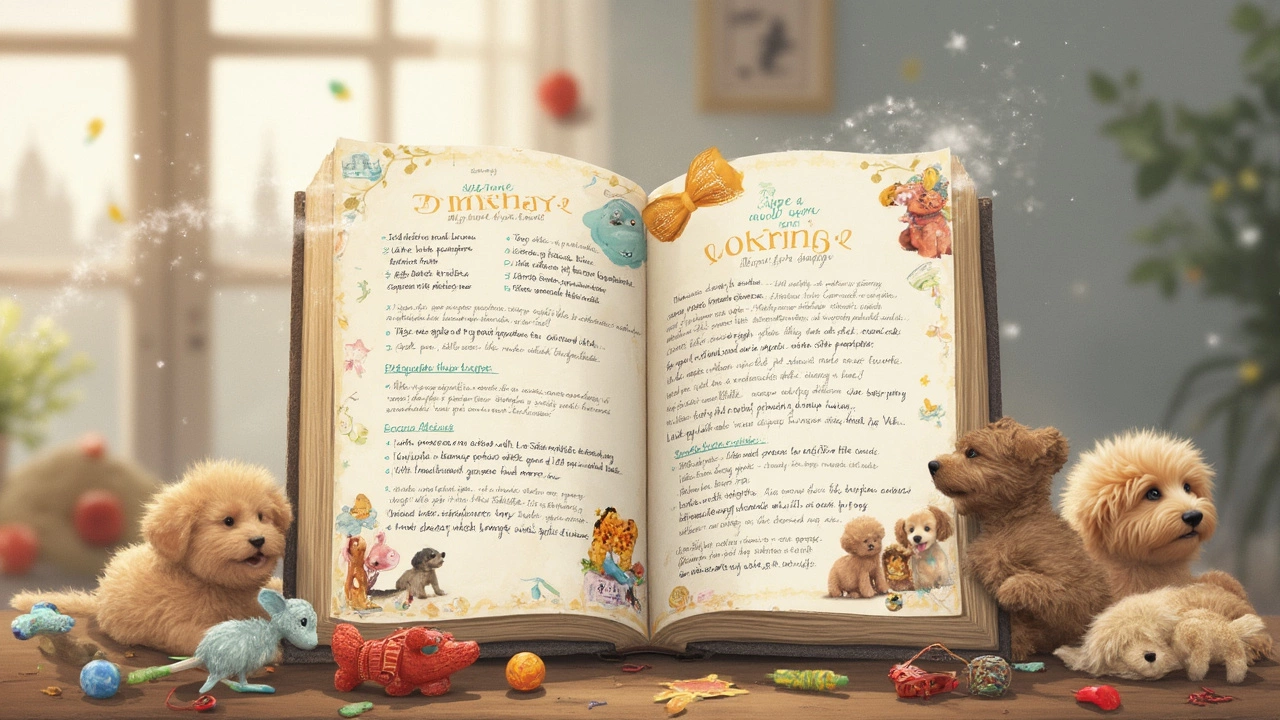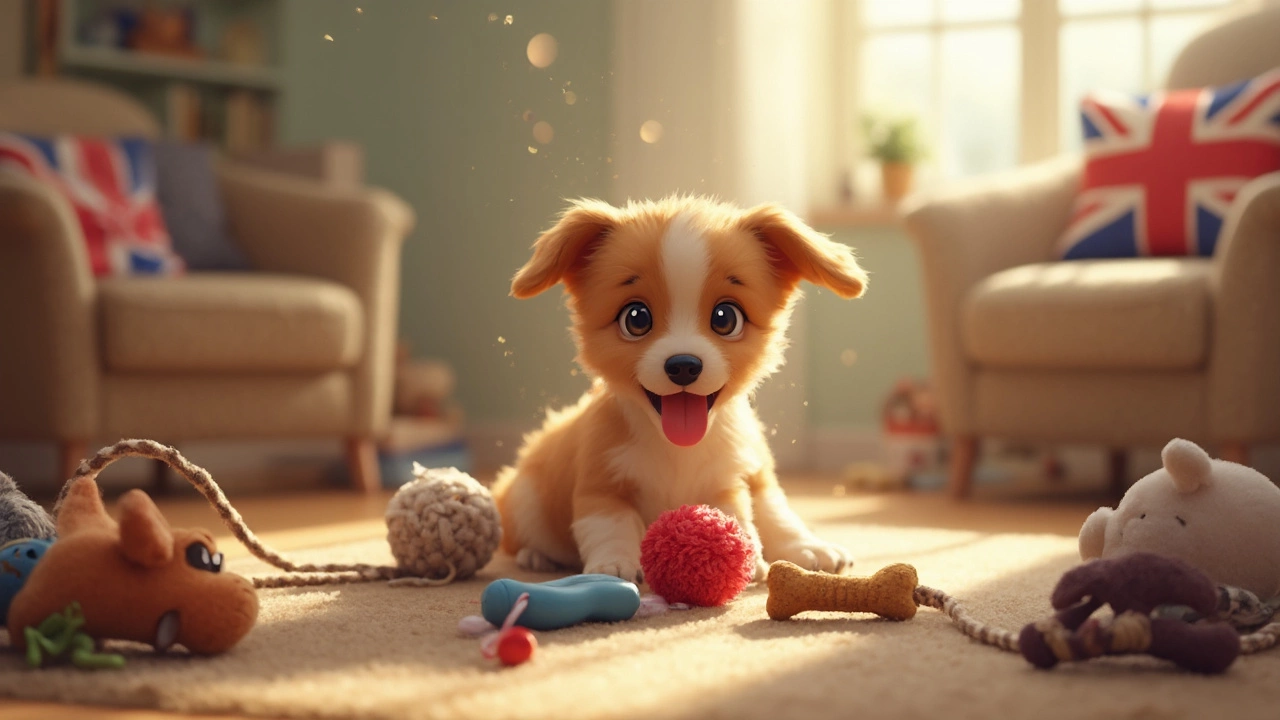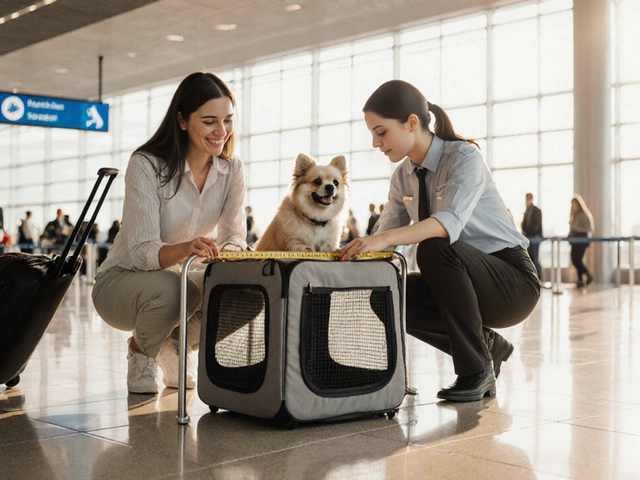Ever heard of the 10-minute rule for puppies? It's a fantastic trick for giving your furry friend the perfect balance of play and rest without overdoing it. Basically, it's all about regulating how long they play with any one toy before moving on to the next activity. Puppies, just like human toddlers, have short attention spans and a ton of energy. The idea is to engage them without wearing them out.
Now, what about the toys themselves? Picking the right ones is crucial. You want toys that are safe, durable, and most importantly, fun! Soft rubber toys work wonders for teething puppies, while puzzle toys can challenge their growing minds.
- Understanding the 10-Minute Rule
- Choosing the Right Toys
- Balancing Play and Rest
- Toy Rotation and Variety
- Safety Tips for Puppy Toys
Understanding the 10-Minute Rule
The 10-minute rule is a simple yet effective approach that helps you manage your puppy's energy levels during playtime. It’s not a hard-and-fast rule but more of a guideline suggesting short, controlled bursts of play. This keeps your pup from getting over-stimulated, which can lead to destructive behavior or exhaustion. Why ten minutes? It's about the average span a young puppy can focus on one play session before needing a break or a change of scenery.
This rule is especially useful for new puppy owners who might not yet know their pup's limits. Imagine trying to run a marathon every day without rest — even the most energetic puppies can get cranky or overwhelmed if they play too long. The solution? Short play sessions and frequent breaks to stop them from getting too tired or agitated.
Benefits of the 10-Minute Play Sessions
- Regulates energy: Keeps your puppy from overexerting themselves, reducing the chance of injuries.
- Prevents boredom: Short sessions keep activities interesting and prevent your pup from losing interest over time.
- Encourages mental development: Switching toys or games keeps their mind engaged, promoting cognitive growth.
Applying the Rule Based on Age and Breed
While the 10-minute rule serves as a solid guideline, each puppy is unique. Smaller breeds or younger pups might need shorter play sessions, perhaps only five minutes at a time, while larger or more rambunctious breeds might handle slightly longer activities. Observing your puppy’s behavior is key here. If they start to lose interest, get too excited, or begin panting heavily, it might be time for a break.
Maximizing Play Efficiency
To get the most out of this rule, introduce a mix of puppy toys during playtime. Rotate through a variety of engaging toys—from chew toys to simple puzzles—keeping your pup curious and entertained. By adhering to the 10-minute rule, you're not just keeping them occupied; you're creating a balanced routine that adapts to their growing needs.
Choosing the Right Toys
When it comes to picking puppy toys, it’s all about knowing what works best for your pup’s age, size, and chewing habits. You wouldn't want to give a tiny Chihuahua the same toy you'd hand to a chunky Lab pup, right?
Age and Size Matter
First off, consider your puppy's age. Younger puppies, especially teething ones, crave something soft yet durable. Rubber toys and plush toys with squeakers are generally a hit. For bigger, older puppies, you might want to introduce tougher toys that can withstand their stronger jaws.
Material and Durability
Material is key. Choose non-toxic toys that are sturdy enough not to fall apart easily. Avoid toys with small parts that can be swallowed. High-quality rubber, nylon, or even durable canvas can be perfect.
Engage Their Minds
Puppies are like sponges. They love learning and figuring things out. Puzzle toys or treat-dispensing toys offer mental stimulation that can greatly benefit a curious pup. Check out interactive balls or toys with compartments that challenge their smarts.
Get Playful with Variety
Keep it interesting by rotating toys every few days. This keeps your puppy engaged and avoids boredom. Try mixing different types of toys: chewy, plushy, and ones that roll or bounce erratically.
What’s fantastic is that the right toys promote healthy chewing behavior and help with teething relief, all while giving you peace of mind that your pup’s occupied and content. Remember, happy playtime means a happy puppy. So, make the right choices and watch your little buddy thrive.

Balancing Play and Rest
When it comes to raising a happy puppy, knowing when to hit the pause button is key. Just like kids, puppies need their downtime. Following the 10-minute rule helps manage their boundless energy while keeping them healthy and happy.
Why is this balance so important? Puppies, especially little ones, tire quickly. Overexertion can lead to problems later on. Think of the play sessions as bursts of energy where they explore, learn, and bond with you. After about 10 minutes, letting them take a break isn't just a choice—it's a must!
Recognizing Signs of Exhaustion
It's crucial to understand when your puppy has had enough. Signs they're ready for a break include excessive panting, slowing down, or simply losing interest in toys. If your puppy flops down mid-play, it's time for a breather.
Effective Rest Strategies
- Quiet Space: Create a cozy, quiet space for your puppy to retreat. This could be their crate or a corner with a comfy blanket.
- Hydration: Make sure they have access to fresh water after play. Puppies can get dehydrated quickly.
- Nap Time: Schedule mini-naps throughout the day to recharge their batteries. Puppies usually need at least 18-20 hours of sleep a day!
So, next time playtime kicks off, remember the magic of the 10-minute rule. It’s about keeping your puppy's joy meter full while ensuring they're not overdoing it. Happy puppy, happy you!
Toy Rotation and Variety
Keeping your puppy engaged is all about mixing things up. Imagine playing with the same toy every day—pretty boring, right? Puppies are no different. Introducing variety in their toys can keep them mentally stimulated and happy. But there's a method to this madness called toy rotation.
Think of toy rotation like creating a mini-exhibition of your dog's favorite playthings. By selectively swapping toys in and out, you give your puppy something fresh to look forward to.
Why Rotate Toys?
Imagine if every day involved playing with the same three toys. It wouldn’t take long before your pup loses interest. With rotation, you keep toys new and exciting, preventing them from becoming just another chew object. Pet surveys indicate that dogs show increased interest and playtime when they encounter "new" toys at home.
How to Implement Toy Rotation
- Gather all your puppy’s toys in one spot. Reflect on which ones they play with most and which are not getting much love.
- Choose a few toys—around four to five—to be available for play that week. Store the rest out of sight, but not out of mind!
- Keep track of toy use, allowing a week or two with the current selection before swapping them out with some "hidden" ones.
- For added excitement, occasionally introduce a new puppy toy into the mix. It doesn’t always have to be a purchase; you can swap with friends or use a different old toy creatively.
Benefits of Variety
Besides keeping boredom at bay, having a variety of toys caters to different skills and needs. Chew toys for teething, fetch toys for exercise, and educational puzzles for mental uplift. This variety ensures balanced growth for both them and you.
Ultimately, when you rotate toys and introduce variety, you’re not just keeping their environment lively. You're nurturing their curiosity and helping them develop all sorts of skills. And hey, a happy puppy means a happy life for the both of you!

Safety Tips for Puppy Toys
Bringing a new puppy home is super exciting but also comes with big responsibilities. One of those is ensuring their puppy toys are safe and suitable. How do you know which ones are the best? Let's dive into some top safety tips.
Inspecting Toys Regularly
Puppies love to chew, and those tiny teeth can wreck even the sturdiest toys. Regular checks are necessary to make sure no toys are falling apart. Small parts could be hazardous and must be discarded if they're coming loose. It may seem like a hassle, but it’s worth it to keep your pup out of harm's way.
Size and Durability
Size really matters when it comes to puppy safety. Toys that are too small can become choking hazards. Always choose toys bigger than the dog's mouth and make sure they're sturdy enough to handle some serious gnawing. Heavy-duty rubber toys are often a safe bet for most puppies.
Material Matters
The materials used in puppy toys can make a real difference. Natural rubber, cotton, and nylon can be much safer than some plastics that might contain harmful chemicals. Always look for non-toxic labels. For example, toys marked BPA-free are a safer choice for chewing.
“It's always advisable to supervise your puppy with new toys initially to ensure their safety and observe any potential destructive chewing habits,” says Dr. Emily Watson from the Pet Wellness Clinic.
Table: Toxic vs. Non-Toxic Toy Materials
| Toxic Materials | Non-Toxic Alternatives |
|---|---|
| Phthalates | Natural Rubber |
| BPA | Cotton |
| Lead | Nylon |
Keep It Clean
Puppy toys tend to get dirty, so keep them clean to prevent bacteria buildup. Wash the toys regularly, especially those that spend time outside or regularly end up in your puppy's water bowl. A wipe-down with mild soapy water works for most toys.
With these simple tips, you can ensure that playtime is not only loads of fun but also safe and sound for your puppy. Safety first, happiness follows!







